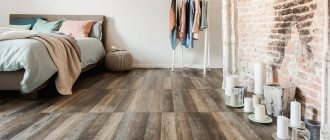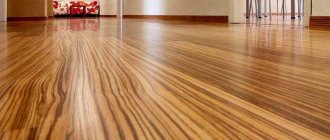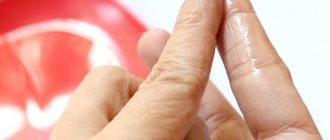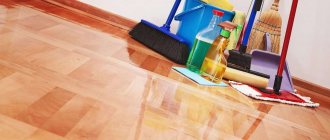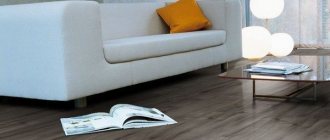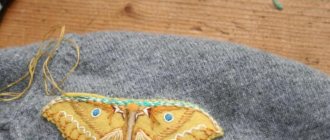18771 0 4
Icer June 1, 2016Specialization: master in the construction of plasterboard structures, finishing work and laying floor coverings. Installation of door and window units, finishing of facades, installation of electrical, plumbing and heating - I can give detailed advice on all types of work.
If you have linoleum on the floor, then in order for the coating to look attractive, you need to periodically update it. Many people don’t do this, and after just a year or two the surface looks untidy and worn out. I will tell you how to keep the floor in excellent condition; it is enough to carry out the work once every six months, and it will not take you much time, but the result will be excellent.
In the photo: restoration of linoleum literally transforms the floor
My chimney sweep
The most effective remedy is to carry out wet cleaning. Most often, to return the shine to linoleum, it is enough to simply wash it thoroughly. For this purpose, both home-prepared and purchased products are suitable.
- Dilute milk with water in a 1:1 ratio; the resulting solution should be slightly warm. Wash the linoleum thoroughly with it.
- Potato decoction will restore the lost shine to the floor covering. To do this, boil a few potatoes for 30-45 minutes, drain the water, cool and grate the linoleum.
- Among commercial soft floor cleaners, Forbo is the most popular. It must be diluted with slightly warm water in a ratio of 1:10; if the linoleum is very dirty, a higher concentration of 1:3 is acceptable. Apply the resulting solution to the floor and leave for 15-25 minutes, then scrub with a soft brush or sponge and rinse with plenty of water.
The above products are well suited for washing linoleum made from natural materials (their composition: wood flour, linseed oil, pine resin, limestone powder, natural dyes).
If you have artificial turf (polyvinyl chloride), you need to use more active agents.
- Add a little liquid soap or dishwashing detergent to the same solution with milk.
- Add 100 ml of vodka or 50 ml of alcohol to 1 liter of water at room temperature with detergent, mix everything well. Rub the resulting product onto particularly dull areas and leave for 15-30 minutes, then rinse well with water and wipe dry.
- Grate the laundry soap on a coarse grater and dissolve it in 10 liters of water. Using the resulting solution, use a brush to thoroughly wash the floor, removing all visible dirt.
The following methods are good for removing various stains from the surface of linoleum:
- Dishwashing detergent applied for 10-15 minutes and then rinsed with water works well with drops of grease.
- A regular eraser can help remove black streaks left by shoes that are difficult to remove. It is enough to rub the stained area with it. You can also get rid of them using solvent or gasoline applied to cotton wool.
Cleaning linoleum from dried wallpaper glue: tips, recipes
Wallpaper glue that remains on the floor after renovation can be removed in three ways:
- Soapy solution. Suitable in cases where the glue has not dried on the floor for several days and is quite “fresh”.
- Special floor cleaner. There is a large assortment of them in the store and each one effectively fights pollution.
- White spirit will help remove traces of old and dried glue from the floor.
Linoleum cleaning products
Restoring old linoleum using professional means
Sometimes simply washing the floors, even using prepared or commercial products, is often not enough. In such cases, it is worth resorting to more effective methods. One of the most radical is the use of various mastics that contain wax. Before applying it, it is important to properly prepare the surface:
- first treat the linoleum with a stripper (a moderately alkaline low-foam agent, for example INTERCHEM 101, costs about 800 rubles for 5 liters), it will help get rid of accumulated dirt and remove old mastic.
- then take the polish and pour in small puddles 2 meters apart, which you then spread with a soft brush or mop over the entire linoleum.
To make unevenness on the floor less noticeable, apply the product perpendicular to the window that provides maximum sunlight.
The number of layers depends on how badly the linoleum is damaged; you may need 5-6. You should wait about 30-40 minutes between each coat before applying the next one.
There are special machines on sale that help distribute the floor polish more evenly, but due to their high cost, not everyone can afford them. In addition, you can use a special mechanism for polishing the floor only on natural linoleum; they are not used for artificial ones.
After applying the last, final layer, leave the room to dry completely overnight (10-12 hours), only then can you use the linoleum again.
Which colors to choose
The choice of paint for linoleum depends on the required drying speed, the degree of wear of the coating and the required durability.
Alkyd paints
Alkyd resin paints and pigment additives are an improved type of old oil-based coatings and enamel. They have gained popularity due to their brightness and color stability, high adhesion and durability. Disadvantages include the appearance of yellowness over time and a pungent odor when performing work. There are several types of alkyd compounds. For linoleum it is better:
- Classic enamel - dries in 3-5 hours, completely fills the pores, forming a durable film, does not wear off or deteriorate for a long time.
- Chlorinated rubber – resistant to alkali, alcohol and acids. Rubber does not allow moisture to pass through, therefore preventing the formation of mold and mildew. The coating will dry in 2 hours. The surface withstands scratches and impacts.
- Pentaphthalic is the most budget option. It doesn't take long to wash, but it will take about a day to dry. It grips strongly, does not crack and does not lose color.
The layer must be applied to a previously prepared surface. Durable enamel can be used to cover stairs, supporting structures, fences and other decorative elements.
Acrylic paint compositions
Acrylic is a synthetic compound, otherwise known as plexiglass. Such options are much more expensive than alkyd ones, but they do not emit a toxic odor, and the uncured composition can be easily washed off with water. Acrylic dries quickly and has high adhesion to PVC surfaces, so it is immediately absorbed. The material does not turn yellow over the years and withstands scratches, impacts and other threats of abrasion.
Oil paints
In austerity mode, linoleum can be painted with oil-based compounds. They are inexpensive, have high adhesion to floor surfaces and create a glossy shine. After application, the materials are not covered with streaks and remain in a uniform and thin layer. Oil-based paints dry quickly, have a strong toxic odor and quickly wear out under mechanical stress.
Repairing serious damage
To disguise deep scratches, buy putty (for 200 rubles, 1.4 kg), the color that best matches the color of the linoleum. Using a wooden or other stick, apply the product to the crack in the coating, leave for a while (indicated on the package) to dry completely. Then take fine sandpaper and smooth the surface, removing excess putty. Only after these repairs can the floor polish be applied.
If part of the linoleum has come off, but the defect is almost invisible on top, you should do the following: remove dirt and treat the lower part of the torn piece with any degreaser (for example, gasoline or solvent), lubricate it well with glue and apply it to the defect site, press it down with a weight on top for better fixation. It is important to ensure that there are no dents when pressing, otherwise the appearance of the coating will deteriorate. After the glue has dried, treat the coating with wax; this will make such local repairs less noticeable.
If significant defects appear on the linoleum, cut out the damaged area and replace it with a similar one. Of course, if you kept the remnants of the coating after the repair, you didn’t throw it away. For a better fit, degrease and then apply the patch. Afterwards, you can also treat the linoleum with wax.
If there is no piece suitable in size and color, you can replace it with an unsuitable one. But in order for the replacement to look harmonious, come up with a shaped insert that will look like a design element and not stand out from the overall renovation concept.
What is the best way to wash linoleum so that it is clean and the floor sparkles like new?
Alina BorisovaAuthor of the website “Moem-clean.ru”
Linoleum is one of the most popular floor coverings, especially for high-traffic areas: kitchens and hallways. Its main advantages are strength, durability and wear resistance. Coverings come in a wide range of colors and textures, so choosing linoleum may not be so easy. There are different types of linoleum in terms of strength class and load-bearing capacity, however, in order for the floor to retain its original attractive appearance longer, it must be properly cared for.
Prices for linoleum restoration products
| Means | Description | Price for the smallest package (RUB) |
| Forbo Eurocol 893 | Cleaner for natural coatings. | 300-500 |
| FL Fourcover | Professional, used for washing linoleum. | 300 |
| DEC | For hand washing. | 300 |
| Glutoclean | Concentrated product. | 700 |
| HG | Concentrate for washing and polishing, does not require rinsing. | 600 |
| Citric | Restores the shine of artificial turf. | 700 |
| Mastic Eurokol | For rubbing coatings and giving them shine | 800 |
What to do if the floor covering has lost its shine
In this case, there are ways to help update the gloss. Some procedures must be done regularly. First you need to inspect the floor covering to assess the condition of the material. Or maybe it is very worn out and can simply be replaced?
First you need to stock up on cleaning products and tools:
- soft sponge;
- dry soft rags;
- composition for cleaning from dust and old polish;
- a brush with short soft bristles;
- polish.
Description of the process and main types of work
In this section, I will talk about the two main steps that are most often required when updating the coating. And if the first of them is carried out only if necessary after inspecting the surface, then the second is mandatory in any case.
Removing stains and dirt
First of all, you need to carefully examine the surface in order to assess its condition. Sometimes the material is so worn out that it is still better to replace it, but if the coating is still more or less normal, then you can try to transform it. To begin with, I want to give some general recommendations:
| Treatment with soap solution | No matter how dirty the linoleum is, always start work by washing the surface with a solution of laundry soap. Very often, such a simple solution allows you to clean the surface from most stains. |
| Caution when working | Everything is very simple here: you cannot use boiling water, pure soda, undiluted ammonia and other chemicals to remove stains. All of these products can cause streaks on the surface, yellowing of individual areas, or tarnishing of the material. |
| Pre-test the composition | It is difficult for a person far from the construction industry to determine the type of material by eye in order to make sure that the product is suitable in his case. In order not to spoil the linoleum, do this: first treat a small area of the floor in an inconspicuous place - under furniture, radiators, etc., even if a stain appears there - it is not as bad as if it formed in the middle of the room |
| Don't delay removing stains | Everything is very simple here: firstly, fresh contamination is removed much faster and easier, and secondly, if you carry out the work periodically, the scale of contamination will not be very strong. This is due to the fact that there will be an additional protective layer on the surface, we will talk about it in the next section |
What not to do
When no means work, there is a temptation to use something more serious. So, linoleum does not tolerate some things:
- High temperature. You can wash it with warm water, but not hot. The use of steam cleaners that produce high-temperature steam is questionable. It may well damage the coating. If you want to try, please, but at your own peril and risk.
- Abrazivov. Abrasive products - powders - can be effective. But they scratch the surface, which is why dirt then eats into these places “better” and faster.
Water, gentle products - that’s what we try first - Mechanical abrasives. A brush with stiff synthetic bristles is very good at cleaning linoleum from stubborn dirt. But using a metal scraper, pumice stone or other similar means is, again, at your own peril. The damage may be worse than the stain.
This is something you don’t need to do with linoleum. There is no need to apply new products over a large area without testing. Even if someone advised you from their own experience of a tried and tested composition. Linoleum may be different and the result may not be pleasing. Therefore, we first test everything on a small area.

